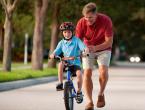Teaching a child to ride a two-wheeled bicycle
Sooner or later, your little one will grow up, and it will be time to move him from a small three-wheeled bike to a two-wheeled bike, learn to balance and ride on his own.
There is such a common phrase: "It's like riding a bike." It means the following: if you have learned to ride a bike at least once, you are unlikely to forget how it is done. It's for life. Therefore, the stage of teaching a child to ride a two-wheeled bicycle is especially important.
When should training start?
In general, it is already possible to put children on two-wheeled bicycles from the age of two. For them, bicycles with twelve-inch wheels were specially invented.
However, the ideal age for learning to ride a two-wheeled bike (and without safety wheels) is between four and six years old. At this age, the child already quite well understands what they want from him, and will quickly get used to it. It's okay if the learning process starts later.
What is required of parents teaching a child to ride a two-wheeled bicycle

In order for your kid to be able to ride a two-wheeled bike confidently, you need to help him with the following:
- Deal with feelings of insecurity and fear.
- Learn to keep balance.
- Learn to pedal.
- Learn to drive.
In order for the child to be able to do all this, a number of simple and not very steps are required from the parents.
You can teach riding immediately on a two-wheeled bicycle, or you can take the so-called “runbike” as a training one. This is a minibike, the characteristic feature of which is the absence of pedals. They, as a rule, captivate the baby and teach him to move.
Remember: it can take from one day to several weeks to train a child. The ideal age for learning is four to six years old. Do not rush your child if something does not work out for him. Be patient and keep practicing.
Ways and recommendations on how to teach a child to keep balance on a two-wheeled bike

Below are ways to teach a child to balance on two wheels.
Riding with optional suspension wheels
Basically, bicycles for children with two large wheels come with additional wheels, with the help of which it is easy to teach the child to maintain balance correctly.
These bikes are usually safe, the baby will not fall off them.
The main thing is to correctly adjust the height of the additional wheels, as well as explain how to turn the steering wheel correctly so as not to tip over when cornering, especially when accelerating at high speed.
One of the most common mistakes is that the small training wheels are set flush with the main wheels (more precisely, with the rear wheel). In no case should they touch the ground at the same time.
When the kid gets used to riding a new bike, learns to control it and brake properly, you can raise the wheels higher. Under the condition of regular skating, the baby will keep his balance better, and soon he will no longer need training wheels - he can safely remove them.
Note that this method of training is most suitable for skiing in the city, on paved paths. But where the roads are uneven, there are many pits and potholes, it is unlikely to be effective, moreover, it can even become dangerous.
Riding without additional wheels, while supporting the child
Mom or dad in this case, supporting the baby by the shoulders, run behind or to the side of the bike. We advise you not to hold the saddle - this is ineffective, because you will adjust the position of the bike for the child. It is also completely inefficient to hold the steering wheel, because your baby will not learn to balance if you steer for him.
You should train in this way in open areas, go straight. Parents should not try to influence the movement of the bike. Let the baby steer himself, because at this stage his main task is to maintain balance.
At the same time, many young velobikers can independently balance themselves as early as the age of five or six years (and in some cases even earlier).
To support a child without arms, you can also use the "towel" method: wrap the child around the waist with a tourniquet made from a towel. But in no case should you wrap too much.
Tips for teaching your toddler to ride a two-wheeler

Finally, we will give some tips for teaching a child to ride a two-wheeled bicycle:
- You should not learn to ride a bike if the bike is too big for the baby. It is better that it be even a little small, so that the child, in which case, could rest his feet on the ground in order to prevent a fall.
- Don't rush your child. He must "ripen" himself to independent riding on a two-wheeled friend. And enjoy riding it.
- You can set a positive example for your child to ride a bike. The kid will see that you are happy and can handle the bike without any problems, and he will certainly want to try it too.
- We advise you to buy protective equipment for the baby: a helmet, knee pads, elbow pads. They will protect against injuries, abrasions and bruises. A kid who has fallen off a bike may not want to continue learning in the future. However, if he does not receive damage when falling, it will only benefit.
- Teach your child not only the process of riding, but also, at the very beginning, how to sit on a bike correctly. Until the child sits down, hold the bike.
- Try removing the pedals so that the baby can ride without them, getting used to the bike. You can ride without pedals for one to two weeks (the baby can push off the ground with his feet, learning to keep balance), and then put them in place and show the child how to twist them correctly
- You also need to lower the saddle a little. Subsequently, when the baby learns to balance, the saddle should be gradually raised.
Teaching a child to ride a two-wheeled bicycle is not a very simple task, but at the same time it is quite feasible. The child must learn to keep balance, and parents must always be there to help in case of emergency.
You can use various methods of teaching skating, and be sure to take care of fall protection: helmets, knee pads and elbow pads. And most importantly - do not rush the child. Even if the training takes more than one week, the child should enjoy riding. Only in this way will the exercises bring the expected effect.
Teaching a child to ride a two-wheeled bicycle




